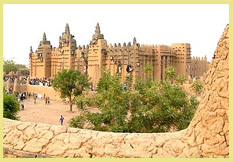




Fortified Towns of the Trans-Sahara Trading routes

The western half of the Sahara has been criss-crossed by trading routes and camel caravans for centuries. These run East-West along the fringes of the desert, and North-South between the population centres of the Atlas Mountains in the north, and the great civilisations of riverine West Africa in the south. The towns that grew up around the fringes of the desert served as ‘supply and re-fuelling stations’, where trade and learning also prospered as wealth was accumulated.
The towns of the desert fringes share many characteristics. Because they are built around water sources, river mud is often used as a primary building material. Flat-roofed (often 2- or 3-storeyed) houses are closely packed together with narrow shaded alleys to keep out the heat, and high plinths at all the doorways to keep out the blowing sand. Houses are inward-facing and arranged around a shady courtyard. There was always a defensive wall, and palms groves around a nearby oasis. The spread of Islam along the trade routes meant that towns developed as religious centres, with numerous mosques and religious schools, even (in the case of Timbuktu) a major university. Today, precious ancient manuscripts and religious art are often kept by local custodians in wooden chests - rather than curated museum cabinets – and these bear testimony to the level of cultural development in these desert outposts.
There are five world heritage properties in this category, each in a different country. Two of them – the M’Zab Valley in Algeria and the Ancient Ksour of Mauritania – are ‘serial sites’ comprising a number of separate towns some distance apart. Most are ancient settlements, dating back at least 1,000 years. Ghadames is probably the oldest, while the Mauritanian and Algerian Ksour developed from the 11th and 12th centuries, Timbuktu was at its zenith in the 15th and 16th centuries, while the oldest parts of the Ksar of Ait-Ben-Haddou in Morocco are thought to be relatively recent, dating from the 17th century.
During the hey-day of trans-Saharan trade, between the 15th and 18th centuries all manner of goods were traded through these towns, including slaves, gold, salt, ivory, leather and ostrich plumes. But the abolition of the slave trade and the development of sea-borne trade routes from Europe to West Africa saw their gradual demise through the 19th and 20th centuries. Today, some of them are being engulfed by the advancing desert, crumbling away into the environment from which they were fashioned as people have moved out to seek a better life elsewhere. The future of most of these places may soon rest on tourism.
To read more about each of the fortified towns of the trans-Sahara trading routes, and see a slideshow of each place, follow these links:




.jpg)